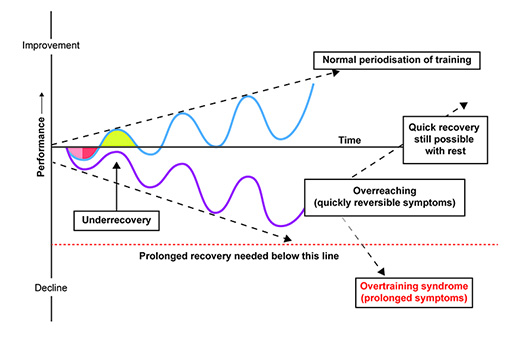6 The fine line between overreaching and overtraining
Physiologists suggest that any subsequent training session after an initial training stress is best placed in the supercompensation phase.
By examining Figure 7 you can see that, in the periodisation (i.e. systematic scheduling) of training, recovery and supercompensation phases lead to gradual improvements in performance. However, subsequent training when recovery is incomplete (i.e. underrecovery) leads to ‘overreaching’. This is manageable provided a quick recovery is still possible with rest (ranging from days to weeks). Overreaching is often an intentional part of elite training periodisation.
Overreaching becomes overtraining when the red horizontal line at the bottom of Figure 7 (the x-axis) is crossed – that is when prolonged symptoms persist (e.g. fatigue, insomnia, agitation, weight loss, infections/illness (Kreher, 2016)). Recovery will then take weeks to months. If this overtraining condition continues it can lead to burnout.
From the physiological basis of overtraining, you can see there is a fine line between overreaching and overtraining – from preserving your body's ability to repair and rebound, and pushing yourself into a downward spiral. Recovery and rebound (supercompensation) are the key processes that differentiate a tired recreational exerciser or athlete from someone who has gone too far and has crossed the line separating overreaching from overtraining.

